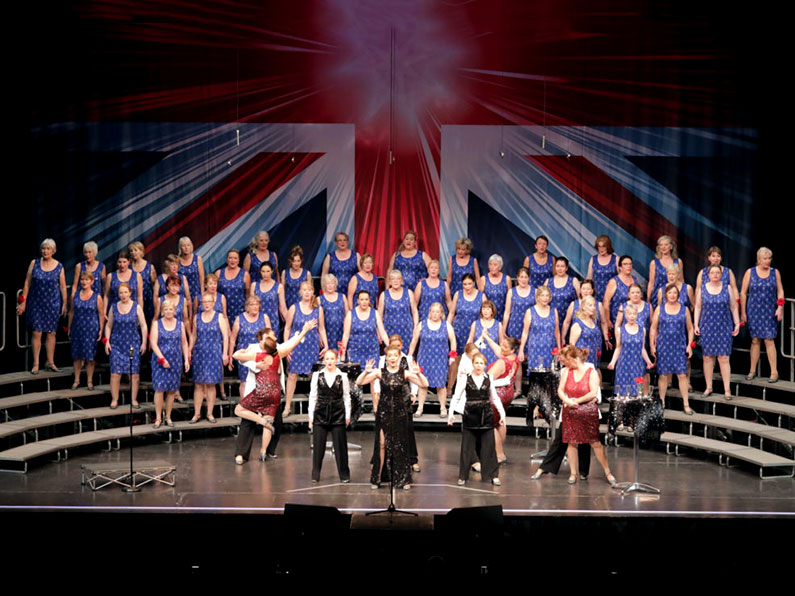Enhancing performance through vocal expression
The Repertoire
Fascinating Rhythm has a diverse repertoire of songs well-suited to our style of a cappella singing. From show tunes like “City of Stars”, “This Is Me” and “Feeling Good” to a ten-part arrangement of ELO’s “Mr Blue Sky”, we have songs for every occasion, and we love to share them with our audiences at concerts and competitions.
Creating the classic harmonic barbershop sound is a key part of our craft, but Fascinating Rhythm also tries to connect emotionally with a song to give a more authentic performance. As well as using movement to enhance the song’s meaning, we express the emotions behind the lyrics and music using our voices and just as with visual performance, achieving unity in our vocal sound is an important aspect of making a song entertaining.
Professional vocal trainer Karen, our pitch-perfect Baritone Section Leader and trainee LABBS Singing Judge, has kindly agreed to share her top hints and tips for adding some vocal ‘wow’ to any song:
What is vocal expression?
The Ladies Association of British Barbershop Singers (LABBS) promotes a cappella four-part harmony singing in the barbershop style. Under competition conditions, LABBS singing category judges are looking to “…evaluate the degree to which the performer achieves artistic singing in the barbershop style […] through precise intonation, a high degree of vocal skill, a high level of unity and consistency within the ensemble as well as the use of the vocal expression.”
The five key elements of barbershop singing are:
– Intonation – precise harmonic tuning and staying in pitch
– Vocal quality – well-supported, freely-produced, resonant and accurate singing
– Unity within the ensemble – synchronisation and precision, matched vowel sounds, good diction and articulation
– Expansion and ring – well-sung chords and a balanced sound
– Vocal expression – nuance, dynamics, tone ‘colour’ and use of artistic effects
So, vocal expression is just as much a part of the barbershop style as singing in harmony and in tune, breathing effectively and using the voice as a musical instrument.
How do I ‘do’ vocal expression?
Vocal expression covers a range of techniques you can use to make a song sound more interesting:
– Dynamics are about volume – that is, how loudly or quietly you are singing. You can vary your volume across the whole of a song, across a particular phrase, or even within a single word.
– Tone colour is made up of the resonance of your voice, your vocal placement (for example, throaty or nasal) and the timbre (combination of frequencies) that make up your vocal sound.
– Vocal quality describes a spectrum of effects from airy whispering to a brassy, edgy, forced sound. You can change your vocal quality from one word to another or across whole phrases.
There are also artistic effects that can be added to a song.
– Moments of silence, audible breaths or adding vibrato to a word (a purposeful ‘tremor’ in the voice) can emphasise an emotional thought
– Diphthongs change the vowel sound part-way through a word (so ‘night’ becomes ‘nah-eet’); whereas ‘pre-thongs’ (a concept we learned from Frenzy quartet ) add a vowel sound to the beginning of a word (so ‘whenever’ becomes ‘oo-weh-nn-eh-ver’)
– Hard consonants (like ‘c’, ‘b’ or ‘d’) can be used to emphasise the start or end of a word, whilst ‘singable’ consonants (like’ n’ or ‘m’) add a musical softness.
– The way you start a word can also be made more interesting by using a glottal stop for a hard onset or an aspirate, breathy sound for a softer onset.
How can I improve my vocal expression?
One of the best ways to improve your vocal expression is to listen to other singers and choirs from a variety of genres and take inspiration from what they do. Have a think about what effect their vocal expression is creating and whether or not it is working. Then try playing around with your voice, recording yourself and listening back to see how you sound.
By testing things out and finding what feels right, you can internalise and practise the techniques for vocal expression until you can replicate them more naturally. The more you practise, the more you can expand the capabilities of your voice as an instrument. You might even choose to ask a vocal coach to help you work on certain aspects of your singing technique.
Sprinkling on the glitter!
You can think of a song as being like an artwork: notes and words are the pencil lines; dynamics and nuance provide the shading; tone colour adds the colours; and artistic effects are the glitter sprinkled on top!
However, whilst we love a bit of glitter, adding too much would smother the artwork and ruin it. So, consider using artistic effects sparingly for the best impact.
At Fascinating Rhythm, we put just as much work into our vocal expression as we do our visual performance. We talk about the emotional story of a song and the vocal techniques that help us to express it, so we can help each other to give a unified, authentic performance. We love using our voices to connect with and entertain our audiences, but the most magical and rewarding moments come when they are so caught up in a song, they don’t notice us sprinkling on the glitter!
You might like to see other articles in the Fascinating Rhythm Insights series:
01 – Why Singing is Good For You
02 – Making Your Performance Authentic
04 – Teamwork Makes the Dream Work
05 – Why Warm Up?
06 – The New Members Guide to Joining a Choir During a Pandemic!
07 – Breathing to Sing
08 – Junior FR: how it started / how it’s going
09 – Singing is a Family Affair
10 – How we choose Convention songs
11 – Mixing it Up
12 – Love to Sing


